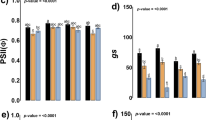Abstract
The influence of saprotrophic soil fungi: Aspergillus versicolor, Penicillium frequentans, Penicillium verrucosum var. cyclopium, and Trichocladium asperum on development, wholesomeness, gas exchange and yield of potato cv. Mila was studied in pot experiments during 1998–2000. The presence of each of the mentioned fungi species in soil accelerated potato germination and stimulated growth of overground plant parts in comparison with control plants. Additionally, the presence of the tested saprotrophes in soil prologed the potato growing period by inhibiting chloroses of necroses. The tested saprotrophic fungi also modified plant physiological processes, such as transpiration and assimilation. The contact of plant root system with soil saprotrophes diminished significantly assimilation and transpiration intensity of overground parts in comparison with the control plants, in all the years of the experiment. However, this response did not reduce the yield of tubers.
Similar content being viewed by others
References
Ciegler A., Hou Ch.T. 1970. Isolation of viridicatin from Penicillium palitans, Arch. Mikrobiol. 73: 261–267.
Einhelling E.A. 1995. Allelopathy: current status and future goals, In: Allelopathy, organisms, processes, and Applications. Inderjit K.M., Dakshini M., Einhelling F.A. (eds.), Am. Chem. Soc., Washington: 1–24.
Friend J., Therelfall D.R. 1976. Biochemical aspect of plant-parasite relationships, Academic Press, London: 354.
Gay G. 1988. Role of fungal hormones in ectomycorrhizal symbiosis, Cryptogam, Mycol. 9: 545–553.
Gwó d E.A. 1996. Molekularne podstawy odpowiedzi ro lin na stresy rodowiskowe, In: Nowe tendencje w biologii molekularnej i in ynierii genetycznej oraz medycynie. Barciszewski J., Łastowski K., Twardowski T. (red.), Wyd. Sorus, Pozna 2: 469–492.
Hadas R., Okon Y. 1987. Effect of Azospirillum brasilense inoculation on root morphology and respiration in tomato seedlings, Biol. Fertil. Soil. 5: 241–247.
Hamasaki T., Hatsuda Y., Terashima N., Renbutsu M. 1967. Studies on the metabolites of Aspergillus versicolor (Vuill.) Tiraboschi.5.Isolation and structures of three new metabolites, versicolorins -A, -B and -C, Agric. Biol. Chem. 31: 11–17.
Harborne J.B. 1986. The role of phytoalexins in natural plant resistance, In: Natural resistance of plant to pests. Green M.B., Hedin P.A. (eds.), Am. Chem. Soc., Washington DC: 22–35.
Hozapfel C.W. 1968. The isolation and structure of cyclopiazonic acid, a toxic metabolite of Penicillium cyclopium Westling. Tetrahedron 24: 2101–2119.
Kacperska A. 1995. Udział hormonów ro linnych w odpowiedzi ro lin na stresowe czynniki rodowiska, Kosmos 44: 623–637.
Kastori R., Petrovic M., Petrovic N. 1992. Effect of excess lead, cadmium, copper, and zine on water relations in sunflower, J. Plant Nutrit. 15: 2427–2439.
Kurek E., Kobus J. 1990. Korzystne i szkodliwe oddziaływanie mikroflory ryzosferowej na wzrost i rozwój ro lin, Post py Mikrobiol. 29, 1–2: 103–123.
Linderman R. G. 1991. Mycorrizal interactions in the rhizosphere, In: The rhizosphere and plant growth. Keister D.L., Cregan P.B. (eds.), Kluwer Acad. Publ. Netherlands: 343–348.
Łukaszewska A., Tonecki J. 1983. Fizjologia tuberyzacji, Post py Nauk Rol. 1: 3–21.
Mahmoud S. A. Z., Ramadan E. M., Thabet F. M., Khater T. 1984. Production of plant growth promoting substances by rhizosphere microorganisms, Zentralbl. Mikrobiol. 139: 227–232.
Malan C.E., Ambrosoli R., Alessandria G. 1969. Intervento di communi infomiceti saprofiti nella umificazione della copertura morta della faggeta alpina, Allionia 15: 133–153.
Moreau M., Trique B. 1966. Recherche des exoenzymes dans les filtrates de cultures de deux moisissures des grains — L’Aspergillus versicolor (Vuill.) Tiraboschi et le Penicillium cyclopium Westl. C.R. Hebd. Seanc. Ac ad Sci., Paris, ser, D, 263: 239–241.
Pietr S.J. 1990. Wpływ saprofitycznej mikroflory ryzosfery na wzrost ro lin, Post py Nauk Rol. 3: 19–38.
Rice E.L. 1984. Allelopathy, Academic Press, New York. 2: 1–422.
Roth R., Torne I., Zaspel J. 1988. Einfluss des Kartoffelanteils in der Fruchtfolge auf die Entwicklung der Bodenversuchung durch Globodera rostochiensis und der Kartoffelertrag in ein Dauerversuch auf Tieflehm-Fahlerde, Tag. Ber. Acad. Landwirtsch-Wiss. DDR Berlin 261: 281–286.
Roztropowicz S. 1996. Plony i skuteczno odmian Bóbr, Fala i Fauna w zwalczaniu m twika ziemniaczanego w warunkach produkcyjnych, Biul. Inst. Ziemn. 47: 149–157.
Schroth M.N., Hancock J.G. 1982. Disease-suppressive soil and root- colonizing bacteria, Science, 216: 1376–1381.
Smyk B. 1982. Biologiczne i biogeochemiczne skutki stosowania mineralnych nawozów azotowych w rolnictwie, Zesz. Nauk. AR im. H. Kołł taja w Krakowie 169: 57–77.
Starck Z. 1998. Response of plants to multiply stresses in aspect of source-sink relations, Acta Physiol. Plant. 20 (supl.): 12–13.
Strzelczyk E., Pokojska-Burdziej A. 1982. Production of auxins and gibberellin-like substances by Cylindrocarpon destructans (Zins) Scholt. Isoalates pathogenic and non-pathogenic to fir (Abies alba) Mill., Phytopathol. Ztschr. 105: 327–335.
Strzelczyk E., Pokojska-Burdziej A. 1984. Production of auxins and gibberellin like substances by mycorrhizal fungi, bacteria and actinomycetes isolated from soil and mycorrhizosphere of pine (Pinus sylvestris L.), Plant and Soil 81: 185–194.
Tien T.M., Gaskins M.H., Hubbell D.H. 1979. Plant growth substances produced by Azospirillum brasilense a nitrogenfixing bacterium and their effect on the growth of pearlmillet (Pennisetum americanum L), Appl. Environ. Microbiol. 37: 1016–1024.
Trique B. 1970. Production in vitro de diverses hydrolases par L’Aspergillus versicolor (Vuill.) Tiraboschi et le Penicillium cyclopium Westling, Annls Nutr. Aliment. 24: 167–175.
Wojcieska-Wyskupajtys U. 1996. Fizjologiczna rola azotu w kształtowaniu plonu ro lin. Cze III. ywienie ro lin azotem a produktywno fotosyntezy, Post py Nauk Rol. 3: 29–42.
Wurr D.C.E., Morris G.E.L. 1979. Relationship between the number of stems produced by a potato seed tubers and its weight, J. Aric. Sci. Camb. 93: 404–409.
Yokoyama S., Oobayashi A., Tanabe O., Sugawara S., Araki E., Ichishima E. 1974. Production and some properties of a new type of acid carboxypeptidase of Penicilium molds, Appl. Microbiol. 27: 953–960.
Zarzy ska K. 1993. Współzale no mi dzy mas bulwy matecznej a niektórymi cechami fizjologicznymi i plonowaniem pi ciu odmian ziemniaka, Biul. Inst. Ziemn. 42: 47–55.
Author information
Authors and Affiliations
Rights and permissions
About this article
Cite this article
Kinga, MZ., Jacek, W. & Krystyna, J. Influence of selected soil saprotrophes on gas exchange, growth and yield of Solanum tuberosum . Acta Physiol Plant 26, 157–164 (2004). https://doi.org/10.1007/s11738-004-0005-z
Received:
Accepted:
Issue Date:
DOI: https://doi.org/10.1007/s11738-004-0005-z




